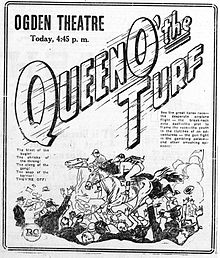John K. Wells
John K. Wells ( May 22, 1878 - April 17, 1949 ) was an American filmmaker . He acted mainly in the early 1920s in Australia , where he traveled with Wilfred Lucas in 1919 to work as the latter's assistant director . There he also worked on various productions with the silver medalist of the 1908 Olympic Games , the Australian Snowy Baker .
life and career
Wells was born in 1878; Little is known about his subsequent life. In 1919 he traveled to Australia with the actual actor Wilfred Lucas, who in the course of his acting career, which lasted from around 1908 to 1940, worked in over 400 different productions and also worked as a filmmaker, to Australia to support Lucas there as an assistant director. The silent film The Man from Kangaroo , shot in 35mm film format, was the first film in which John K. Wells was proven to have worked as Lucas's assistant director. The 35 mm film of the melodrama , which premiered on January 24, 1920 in Australia and on November 1, 1921 in the United States, had a film length of 1,371.60 meters. In the same year, the silent film The Man from Snowy River was released on August 28 , in which Wells worked with the Australian Beaumont Smith on the direction. Wells also made his directorial debut in the hour-long film about the Snowy River , a large river in southeast Australia. A year later, the drama Silks and Saddles celebrated its premiere. In addition to directing the film, Wells was involved in the script , editing and producer . The film was about the company around the horse races, which were particularly popular in Australia, and shows, in addition to the then successful racehorse Kennaquhair , an airplane that was rented for a week especially for filming. It was also one of the first times an airplane was used in an Australian film.
In addition, Wells worked again at Wilfred Lucas' side in 1921 when he appeared again as assistant director on The Shadow of Lightning Ridge . This was also the second film in a row after The Man from Kangaroo , in which the former Olympian and silver medalist Snowy Baker participated. The silent film, which was shot in early 1920 and was not released until over a year later, was a great success in Australia at the time and was therefore also shown in the United States. In 1923 he returned to his home country; after that it became largely quiet around John K. Wells. It wasn't until 1937 that another production involving Wells was released. Wells provided the novel for the romantic comedy Living on Love by Lew Landers , which was eventually adapted as a screenplay by the later Oscar-nominated Franklin Coen . The film is a remake of the Rafter Romance published four years earlier , to which Wells also contributed the novel. After 1937, no other significant production is known to have been made by John K. Wells. Wells died on April 17, 1949, about a month before his 71st birthday, and was buried in Wells Cemetery on Malpass Corner in Pender County , North Carolina . He left behind his wife Ida Laura (1882–1968) and six of his seven children. The third youngest child of the two died in 1928 at the age of nine.
Filmography
- 1920: The Man from Kangaroo (assistant director)
- 1920: The Man from Snowy River (co-directed with Beaumont Smith )
- 1921: Silks and Saddles (direction, screenplay, editing, production)
- 1921: The Shadow of Lightning Ridge (assistant director)
- 1933: Rafter Romance (based on a novel)
- 1937: Living on Love (based on a novel)
Individual evidence
- ↑ SILKS AND SADDLES AT WEST'S in The Register (Adelaide, SA: 1901-1929) (English), accessed on March 9, 2014
- ^ AUSTRALIAN FILMS in The West Australian (Perth, WA: 1879–1954) (English), accessed March 9, 2014
- ↑ James Lenwood Wells at findagrave.com (English), accessed March 9, 2014
Web links
- John K. Wells in the Internet Movie Database (English)
- John K. Wells in the database of Find a Grave (English)
| personal data | |
|---|---|
| SURNAME | Wells, John K |
| BRIEF DESCRIPTION | American filmmaker |
| DATE OF BIRTH | May 22, 1878 |
| DATE OF DEATH | April 17, 1949 |

